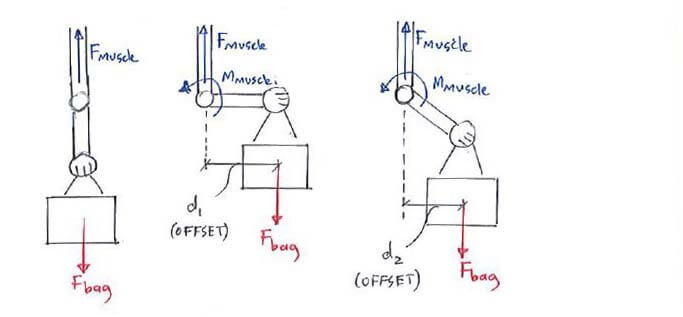 bag at different offsets" width="" />
bag at different offsets" width="" />Being the best kid in the world, you helped your mum to do some groceries. As you’re walking home with a full bag of groceries on each hand, everything was fine, until you have to lift your hand with the grocery bag to open the door. You find that you need to exert more strength just to lift your hand up.
Why is this so? Why do you need to exert more muscle strength although you are carrying the same grocery bag with the same weight?
Well that’s because you need to balance the moment caused by the grocery bag’s weight when you lift your hand. Moment is the rotational tendency of a body when the force is applied at an offset.

Being the best kid in the world, you helped your mum to do some groceries. As you’re walking home with a full bag of groceries on each hand, everything was fine, until you have to lift your hand with the grocery bag to open the door. You find that you need to exert more strength just to lift your hand up.
Why is this so? Why do you need to exert more muscle strength although you are carrying the same grocery bag with the same weight?
Well that’s because you need to balance the moment caused by the grocery bag’s weight when you lift your hand. Moment is the rotational tendency of a body when the force is applied at an offset.

Moment is calculated using the following formula:
Key points to note:
When two equal but opposite forces act on a body at an offset, the forces cancel out but the offset causes a net moment, which we call a couple. A typical example is the torque wrench:
We see that the forces cancels each other out, but the net effect is a couple (moment) about the centre of the torque wrench, which is what untightens the screw.
The concept of couple can be used to “transmit” the force that is acting at an offset on a body. That is, we move the offset force to another point on the body, but at the same time we add the equivalent moment magnitude that is caused by the offset force, as such:
This might sound a little complicated, and the best way to learn is by looking at an example.
Moment is calculated using the following formula:
Key points to note:
When two equal but opposite forces act on a body at an offset, the forces cancel out but the offset causes a net moment, which we call a couple. A typical example is the torque wrench:
We see that the forces cancels each other out, but the net effect is a couple (moment) about the centre of the torque wrench, which is what untightens the screw.
The concept of couple can be used to “transmit” the force that is acting at an offset on a body. That is, we move the offset force to another point on the body, but at the same time we add the equivalent moment magnitude that is caused by the offset force, as such:
This might sound a little complicated, and the best way to learn is by looking at an example.